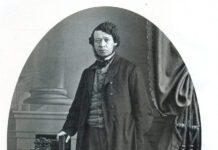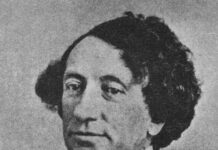In 1862, the United Province of Canada was a deeply divided and unstable place. Since it had been put together by British Imperial orders in 1841, the two sections that had once been Upper and Lower Canada, and today known as Ontario and Quebec, had careened from one crisis to another. For just fifty years, between 1791 and 1841, the two colonies had enjoyed a separate existence, each with its own administration, but the competition between them had become an obstacle to economic growth. Lower Canadian control of the St. Lawrence had interfered with Upper Canada’s economic development. The many issues that divided them included French versus English, and majority Catholic versus majority Protestant.
It was hoped that, by joining them together into one Province of Canada, some of this antagonism would be dealt with, but it was clear to the majority in Lower Canada that the Union had been designed to “swamp the French”, as even officials described it. Although the population of Lower Canada was greater than the Upper half, it had the same number of seats in the Assembly, and it seemed destined to be kept out of the more influential offices of the Crown. But those interested in reform of the system of government in the colony joined with the French representatives to form a powerful party which eventually brought about the changes they sought and Lower Canada maintained a major influence on the formation of governments for most of the Union period.
The combined population of the province in 1861 was 2,507,677, of which Lower Canada had 1,111,586 and Upper Canada slightly more at 1,396,091. The major cities were comparatively small by today’s standards. Montreal had a population of 90,323 and was the largest urban area in the Province. Toronto had 44,821 residents, Ottawa just 14,669. The Irish outnumbered the English, Scots and Welsh combined ( 241,423 Irish to 127,429 English and Welsh and 111,952 Scots).
It soon became a grievance of Upper Canada that, when its population overtook that of Lower Canada, they now became the side restricted in the number of seats available to them in the Assembly. The new cry of the Reformers was “Representation by Population”, or Rep by Pop, and they rallied around the cry of “Justice for Upper Canada!”. More and more, as the 1850’s wore on, it became difficult to form a stable government for the province, with the result that economic stagnation and sectional disputes became ever more bitter. “British” Upper Canadians resented French Lower Canada using their taxes for Lower Canadian infrastructure projects. Lower Canadians resented Upper Canadian Protestants making laws concerning schools which seemed to impinge upon Catholic educational priorities. There seemed to be no end of conflicts and potential sources of conflict.
Even within Upper Canada, the Reformers and those now known as Conservatives were deeply divided. By the early 1860’s, the two most important leaders of these two camps, George Brown for the Reformers and John A. Macdonald for the Conservatives, had a very strong and open personal hatred for one another. Both sides seemed trapped in a system that prevented each from achieving their political goals, and social and cultural development. Politicians were confined within a structure that gave no room for ambition, vision, or anything beyond petty and repetitious sparring and mutual loathing. It was not a pretty picture, but where was the way out?
There had been talk, off and on, about the idea of separating the two old colonies and making them into a federation instead, each with its own assembly. Others had even dreamed of uniting all the British North American colonies into a single country, but there had been no interest shown by the four Maritime colonies in that idea. They had their own visionaries who were advocating a union of just the four lower colonies, Nova Scotia, New Brunswick, Prince Edward island and Newfoundland, into a new Acadia.
Many in those colonies were highly skeptical about having any dealings with the untrustworthy Canadians. There had been talks in 1862 between the five governments about funding a railway line that would run from Sarnia in Upper Canada to Halifax, Nova Scotia. At first, all seemed to have gone well and an agreement had been reached. At least, so the Maritimers thought, until the Canadians reneged on the scheme, leaving their Atlantic cousins angry and deeply suspicious of any further entanglements with the Canadians.
By 1864, there seemed no hope of escape from the straightjacket of the United Province, and no interest among the maritime colonies in any future arrangements with them. Yet, three years later, the Dominion of Canada came into being. The way in which this astonishing achievement came about is a story that sometimes seems something that belongs in a book of fiction. Yet, that story is now our history.








